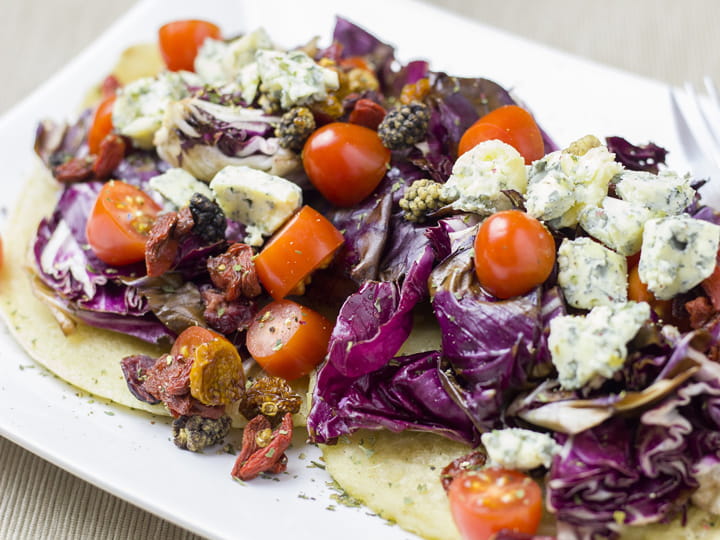The properties and benefits of radicchio

Popular legends on this tasty leafy vegetable abound, because radicchio, sometimes called Italian chicory, was a poor food in rural Veneto.
Indeed while the Doges enjoyed sumptuous and sophisticated dishes, peasants would cook the bitter leafy vegetable native to their countryside, inventing dishes that have since become staples of typical Veneto cuisine.
In reality, radicchio is known to have been used as far back as the age of Plinius the Elder (29 - 79 BC), who in the 'Naturalis Historia' mentions chicory, attributing it with purifying properties.
At the market
Common chicory (cichorium intybus) has given rise to manifold cultivated versions, including ones that are very different both in terms of shape and provenance, including: Red Treviso Radicchio, Catalogna, Rosa di Chioggia and many more.
The most well-known radicchio varieties we can buy at the market include:
- Red Treviso Radicchio, early and late (columnar, with narrow leaves and a semi-closed head);
- Red Chioggia Radicchio (spherical shape and closed head);
- Red Verona Radicchio (elongated shape with broad leaves and closed head);
- Variegated Radicchio (yellowish green in colour with red and purple speckles and open head);
- Green pan di zucchero radicchio (elongated shape, with broad leaves and closed head);
- Green common or wild chicory (there are different varieties, some with jagged edged leaves, other with regular leaves; they do not form a head and tend to be smaller in size).

Properties and benefits
They are rich in water, with a good mineral and above all, fibre content.
This is why they have purifying effects and are perfect for anyone with digestive troubles or constipation.
Red radicchio contains potassium above all, but also magnesium, phosphorous, calcium, zinc, sodium, iron, copper and manganese; it also contains B group vitamins, vitamin C, vitamin E and vitamin K.
The liver is protected, thanks to bitter tasting molecules contained in this leafy vegetable that stimulate bile, helpful in the digestion of fats.
It is a very low energy food, making it useful as part of a low calorie diet.
Fibres contained in radicchio block sugars in blood, which is why it is recommended for those with type 2 diabetes.
Like all vegetables this colour, red radicchio is rich in antioxidants.
It contains anthocyanins, which help prevent cardiovascular risk factors, and tryptophan, which helps fight insomnia.
Indeed it is the starting point for the synthesis of some biological substances, including serotonin (commonly referred to as the "feel-good hormone"), which is a precursor of melatonin, namely the hormone that regulates sleep quality and duration.
Red radicchio is rich in polyphenols and anthocyanins in particular, which determine the purple-red colour of leaves, and are powerful antioxidants with excellent beneficial properties.
These substances exert protective and anti-ageing functions on the entire body. They mainly act on the circulatory system: they have anti-inflammatory and antiplatelet properties.
Anthocyanins useful against water retention
They exert a vasodilatator, antioxidant and protective action for microcirculation.
This is why foods rich in anthocyanins are recommended in cases of fragile blood vessels (cellulite, varicose veins, haemorrhoids), and to reduce negative effects caused by hypercholesterolemia.
Moreover, anthocyanins are also useful for resolving water retention problems as they inhibit the formation of oedemas, the build-up of fluid in intracellular spaces or between tissues.
Useful against psoriasis
This food has a very important role in the treatment and control of psoriasis.
Psoriasis is a chronic inflammation of the epidermis, which can have numerous causes, including stress and psychological disorders.
Eating detoxifying food that fights the oxidative effect of the body results in significant benefits.
The consumption of fibres associated with bitter vegetables, just like radicchio, is useful in alleviating this condition.
Contra-indications
This leafy vegetable is not recommended for anyone affected by gall or kidney stones. Those who suffer from gastroduodenal ulcers should also avoid it.
Radicchio can have stimulating effects on the uterus so seek medical advice before eating it during pregnancy.
In the kitchen

There are so many recipes with radicchio: it excellent when paired with cheeses, fresh and dried fruit, or even for enriching a simple salad.
Some examples include radicchio and walnut sauce, radicchio, speck and mushroom risotto, on toasted slices of bread with robiola cheese and salmon, or as an ingredient in smoothies, with pears and honey for example.

